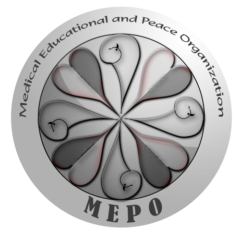Education in the House of Flowers has two components: the traditional public education, and our in-house Montessori education.
- Attending Local Schools
- In-House Montessori Education at the House of Flowers
- The Arts in the House of Flowers
- The Results
- Montessori program photo gallery
Attending Local Schools
We believe it is important for the children to grow up with a solid grounding in their community and in Afghan culture, so since the beginning, even though we had two qualified teachers, the children have attended class at their local public school. This education is quite limited.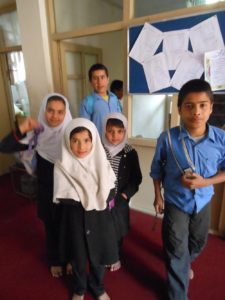
Even ten years after the end of the Taliban conflict there are still not enough schools or teachers, so all schools run two or three shifts per day with classes of 40-50 students. As a result, students are in school for only 3-4 hours a day. (Older and younger children attend in the morning, and middle level children in the afternoon.) The elementary students are only taught language, math and religion. Older students are offered six subjects, including science, social studies and geography, but their six subjects are crammed into 3 or 4 hours at school. Consequently, Afghan education is quickly gaining a reputation of being highly ineffective.
Montessori Education at the House
The House of Flowers’ teachers, Fatima and Qudsieh, are present from 8 am to 3:30 pm. During the time that the children are at the House, the teachers provide a Montessori-based education for them.
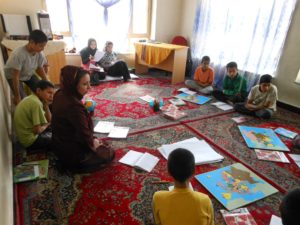 Thanks to the school schedule, the teachers are fortunate to have a full 3 hour work cycle available with the children. As a result, the children at the House of Flowers receive a highly augmented education, and this is evident in the
Thanks to the school schedule, the teachers are fortunate to have a full 3 hour work cycle available with the children. As a result, the children at the House of Flowers receive a highly augmented education, and this is evident in the 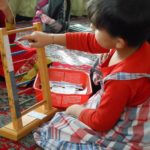 children’s breadth of knowledge and experience.
children’s breadth of knowledge and experience.
The teachers do their best to implement as many Montessori practices in their classrooms as possible, according to the trainings we have done in-house as well as from their own dedicated study and translation of Montessori literature. Their practices include using Montessori materials, giving small group presentations, allowing choice of work, using the 3 period lesson technique, and encouraging artistic follow-up choices. 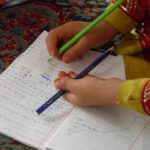 The children do their work on mats and carefully fold them after use. The older children do research and have going-outs. Children also regularly present their work to the other children and guests in an impressive display of confidence and enthusiasm.
The children do their work on mats and carefully fold them after use. The older children do research and have going-outs. Children also regularly present their work to the other children and guests in an impressive display of confidence and enthusiasm.
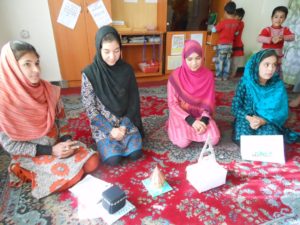 In the two classrooms, supplies such as colored pencils, scissors and paper are out and available to the children at all times, as is a wide selection of Montessori materials and activities including bead bars, squares and chains, divided insets, metal insets, puzzle maps, long bead frame, and the stamp game. The teachers also use the Montessori timelines (such as the Timeline of Human Beings) and geography charts for lessons. Recently they have also been using the Fundamental Human Needs charts and concepts for their history and geography lessons.
In the two classrooms, supplies such as colored pencils, scissors and paper are out and available to the children at all times, as is a wide selection of Montessori materials and activities including bead bars, squares and chains, divided insets, metal insets, puzzle maps, long bead frame, and the stamp game. The teachers also use the Montessori timelines (such as the Timeline of Human Beings) and geography charts for lessons. Recently they have also been using the Fundamental Human Needs charts and concepts for their history and geography lessons.
The teachers have made their own moveable alphabets in Dari, adapted grammar symbols for Dari language, and created nomenclature sets. The smaller children and those primary level children who are too young for school work with Montessori materials in language, math, geometry and geography  especially. (There is less emphasis on practical life areas since the children are involved in practical life nearly all the time at the House. There is a small practical life area for the toddler-age children.) Books are available in the classroom, and children use them often. A set of Farsi encyclopedias and a well-stocked library provide reference materials for the older children’s researches.
especially. (There is less emphasis on practical life areas since the children are involved in practical life nearly all the time at the House. There is a small practical life area for the toddler-age children.) Books are available in the classroom, and children use them often. A set of Farsi encyclopedias and a well-stocked library provide reference materials for the older children’s researches.
During the work cycle in these classrooms, one can feel the level of balance and focus in the children. Visitors who come to observe cannot believe the quality and nature of work being done by the children, nor the peacefulness of the classroom. They remark on how independently the children work, how neat and orderly the children are, and the ease and confidence with which the children make presentations to the group.
The Arts
Afghanistan has a very rich heritage of artistic endeavors, from the intricate mosaic tiling of Islam to  beautiful calligraphy of the Persian language to the unique artistry of miniatures and page illumination. Unfortunately, the only art that is taught in the traditional schools is calligraphy. Thus the arts of Afghanistan are becoming more and more rare.
beautiful calligraphy of the Persian language to the unique artistry of miniatures and page illumination. Unfortunately, the only art that is taught in the traditional schools is calligraphy. Thus the arts of Afghanistan are becoming more and more rare.
The House of Flowers has been able to offer arts education to the children over the past ten years through lessons from a local artist. Besides helping maintain the artistic heritage of Afghanistan, we have found that the children’s engagement in artwork has had multiple benefits. They use it to express themselves, they have developed refined skills of drawing and they use these skills in their schoolwork as well. They have a sense of beauty and very much enjoy decorating their classroom and environment artistically. The children produce beautiful miniatures, and in the process they seem even calmer, even more relaxed. Over the years, their artistic skills have brought them, and others, great joy. It has been a subtle yet very powerful component of the House of Flowers. 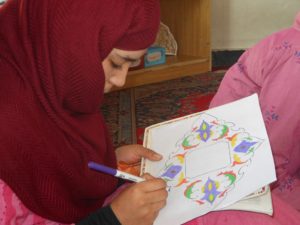
The Results
The Montessori program at the House of Flowers began as an experiment. Frankly, we were not sure if the methodology would work in this context, or if it would be sustainable, especially after Allison, as the Montessori facilitator, left the country. But ten years later, the House of Flowers has demonstrated the resounding success of Montessori philosophy and education, thanks to the power of the method and the dedication and adaptability of the staff.
The atmosphere of the House of Flowers has a very distinctive feel, reminiscent of the peacefulness that one senses when walking into a Montessori school. It possesses a feeling of flow and freedom. The children are relaxed and happy; they can often be heard singing to themselves. They know they are safe to 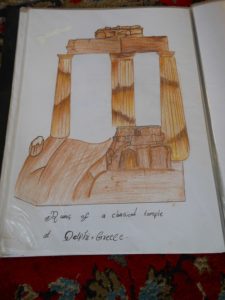 explore and they respect their boundaries. They are creative and artistic. They belong to a family and a community.
explore and they respect their boundaries. They are creative and artistic. They belong to a family and a community.
Perhaps most importantly, they have a unique confidence about them. In contrast to children in other orphanages, the House of Flowers children shake hands with poise, greeting with eyes raised and voice strong. They are extremely well-educated, having been exposed to a much greater range of human culture and knowledge than other Afghan children, and consequently the potential of what they have to offer is immediately evident.
